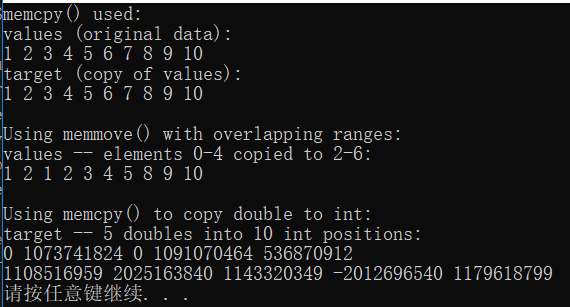memcpy()和memmove()
作者:追风剑情 发布于:2020-3-23 16:25 分类:C
//拷贝数组元素
//void *memcpy(void * restrict s1, const void * restrict s2, size_t n);
//移动数组元素
//void *memmove(void *s1, const void *s2, size_t n);
上面两个函数都从s2指向的位置拷贝n字节到s1指向的位置,而且返回s1的值。所不同的是,memcpy()的参数带关键字restrict,即memcpy()假设两个内存区域之间没有重叠; 而memmove()不作这样的假设,所以拷贝过程类似于先把所有字节拷贝到一个临时缓冲区,然后再拷贝到最终目的地。如果使用memcpy()时,两区域出现重叠,其行为是未定义的,这意味着该函数可能正常工作,也可能失败。编译器不会在本不该使用memcpy()时禁止你使用,作为程序员,在使用该函数时有责任确保两个区域不重叠。由于这两个函数设计用于处理任何数据类型,所有它们的参数都是两个指向void的指针。C允许把任何类型的指针赋给void*类型的指针
示例
- #define _CRT_SECURE_NO_WARNINGS
- #include <stdio.h>
- #include <stdlib.h>
- #include <stdbool.h> //C99特性
- //memcpy()、memmove()
- #include <string.h>
- #include <math.h>
- #include <ctype.h>
- #include <tgmath.h>
- #include <limits.h>
- #define SIZE 10
- void show_array(const int ar [], int n);
- //_Static_assert(sizeof(double) == 2 * sizeof(int), "double not twice int size");
- int main(int argc, char* argv[])
- {
- int values[SIZE] = {1, 2, 3, 4, 5, 6, 7, 8, 9, 10};
- int target[SIZE];
- double curious[SIZE / 2] = { 2.0, 2.0e5, 2.0e10, 2.0e20, 5.0e30 };
- puts("memcpy() used:");
- puts("values (original data): ");
- show_array(values, SIZE);
- memcpy(target, values, SIZE * sizeof(int));
- puts("target (copy of values): ");
- show_array(target, SIZE);
- puts("\nUsing memmove() with overlapping ranges:");
- memmove(values + 2, values, 5 * sizeof(int));
- puts("values -- elements 0-4 copied to 2-6:");
- show_array(values, SIZE);
- puts("\nUsing memcpy() to copy double to int:");
- memcpy(target, curious, (SIZE / 2) * sizeof(double));
- puts("target -- 5 doubles into 10 int positions:");
- show_array(target, SIZE / 2);
- show_array(target + 5, SIZE / 2);
- system("pause");
- return 0;
- }
- void show_array(const int ar[], int n)
- {
- int i;
- for (i = 0; i < n; i++)
- printf("%d ", ar[i]);
- putchar('\n');
- }
标签: C语言
日历
最新文章
随机文章
热门文章
分类
存档
- 2025年3月(4)
- 2025年2月(3)
- 2025年1月(1)
- 2024年12月(5)
- 2024年11月(5)
- 2024年10月(5)
- 2024年9月(3)
- 2024年8月(3)
- 2024年7月(11)
- 2024年6月(3)
- 2024年5月(9)
- 2024年4月(10)
- 2024年3月(11)
- 2024年2月(24)
- 2024年1月(12)
- 2023年12月(3)
- 2023年11月(9)
- 2023年10月(7)
- 2023年9月(2)
- 2023年8月(7)
- 2023年7月(9)
- 2023年6月(6)
- 2023年5月(7)
- 2023年4月(11)
- 2023年3月(6)
- 2023年2月(11)
- 2023年1月(8)
- 2022年12月(2)
- 2022年11月(4)
- 2022年10月(10)
- 2022年9月(2)
- 2022年8月(13)
- 2022年7月(7)
- 2022年6月(11)
- 2022年5月(18)
- 2022年4月(29)
- 2022年3月(5)
- 2022年2月(6)
- 2022年1月(8)
- 2021年12月(5)
- 2021年11月(3)
- 2021年10月(4)
- 2021年9月(9)
- 2021年8月(14)
- 2021年7月(8)
- 2021年6月(5)
- 2021年5月(2)
- 2021年4月(3)
- 2021年3月(7)
- 2021年2月(2)
- 2021年1月(8)
- 2020年12月(7)
- 2020年11月(2)
- 2020年10月(6)
- 2020年9月(9)
- 2020年8月(10)
- 2020年7月(9)
- 2020年6月(18)
- 2020年5月(4)
- 2020年4月(25)
- 2020年3月(38)
- 2020年1月(21)
- 2019年12月(13)
- 2019年11月(29)
- 2019年10月(44)
- 2019年9月(17)
- 2019年8月(18)
- 2019年7月(25)
- 2019年6月(25)
- 2019年5月(17)
- 2019年4月(10)
- 2019年3月(36)
- 2019年2月(35)
- 2019年1月(28)
- 2018年12月(30)
- 2018年11月(22)
- 2018年10月(4)
- 2018年9月(7)
- 2018年8月(13)
- 2018年7月(13)
- 2018年6月(6)
- 2018年5月(5)
- 2018年4月(13)
- 2018年3月(5)
- 2018年2月(3)
- 2018年1月(8)
- 2017年12月(35)
- 2017年11月(17)
- 2017年10月(16)
- 2017年9月(17)
- 2017年8月(20)
- 2017年7月(34)
- 2017年6月(17)
- 2017年5月(15)
- 2017年4月(32)
- 2017年3月(8)
- 2017年2月(2)
- 2017年1月(5)
- 2016年12月(14)
- 2016年11月(26)
- 2016年10月(12)
- 2016年9月(25)
- 2016年8月(32)
- 2016年7月(14)
- 2016年6月(21)
- 2016年5月(17)
- 2016年4月(13)
- 2016年3月(8)
- 2016年2月(8)
- 2016年1月(18)
- 2015年12月(13)
- 2015年11月(15)
- 2015年10月(12)
- 2015年9月(18)
- 2015年8月(21)
- 2015年7月(35)
- 2015年6月(13)
- 2015年5月(9)
- 2015年4月(4)
- 2015年3月(5)
- 2015年2月(4)
- 2015年1月(13)
- 2014年12月(7)
- 2014年11月(5)
- 2014年10月(4)
- 2014年9月(8)
- 2014年8月(16)
- 2014年7月(26)
- 2014年6月(22)
- 2014年5月(28)
- 2014年4月(15)
友情链接
- Unity官网
- Unity圣典
- Unity在线手册
- Unity中文手册(圣典)
- Unity官方中文论坛
- Unity游戏蛮牛用户文档
- Unity下载存档
- Unity引擎源码下载
- Unity服务
- Unity Ads
- wiki.unity3d
- Visual Studio Code官网
- SenseAR开发文档
- MSDN
- C# 参考
- C# 编程指南
- .NET Framework类库
- .NET 文档
- .NET 开发
- WPF官方文档
- uLua
- xLua
- SharpZipLib
- Protobuf-net
- Protobuf.js
- OpenSSL
- OPEN CASCADE
- JSON
- MessagePack
- C在线工具
- 游戏蛮牛
- GreenVPN
- 聚合数据
- 热云
- 融云
- 腾讯云
- 腾讯开放平台
- 腾讯游戏服务
- 腾讯游戏开发者平台
- 腾讯课堂
- 微信开放平台
- 腾讯实时音视频
- 腾讯即时通信IM
- 微信公众平台技术文档
- 白鹭引擎官网
- 白鹭引擎开放平台
- 白鹭引擎开发文档
- FairyGUI编辑器
- PureMVC-TypeScript
- 讯飞开放平台
- 亲加通讯云
- Cygwin
- Mono开发者联盟
- Scut游戏服务器引擎
- KBEngine游戏服务器引擎
- Photon游戏服务器引擎
- 码云
- SharpSvn
- 腾讯bugly
- 4399原创平台
- 开源中国
- Firebase
- Firebase-Admob-Unity
- google-services-unity
- Firebase SDK for Unity
- Google-Firebase-SDK
- AppsFlyer SDK
- android-repository
- CQASO
- Facebook开发者平台
- gradle下载
- GradleBuildTool下载
- Android Developers
- Google中国开发者
- AndroidDevTools
- Android社区
- Android开发工具
- Google Play Games Services
- Google商店
- Google APIs for Android
- 金钱豹VPN
- TouchSense SDK
- MakeHuman
- Online RSA Key Converter
- Windows UWP应用
- Visual Studio For Unity
- Open CASCADE Technology
- 慕课网
- 阿里云服务器ECS
- 在线免费文字转语音系统
- AI Studio
- 网云穿
- 百度网盘开放平台
- 迅捷画图
- 菜鸟工具
- [CSDN] 程序员研修院
- 华为人脸识别
- 百度AR导航导览SDK
- 海康威视官网
- 海康开放平台
- 海康SDK下载
- git download
- Open CASCADE
- CascadeStudio
交流QQ群
-
Flash游戏设计: 86184192
Unity游戏设计: 171855449
游戏设计订阅号








